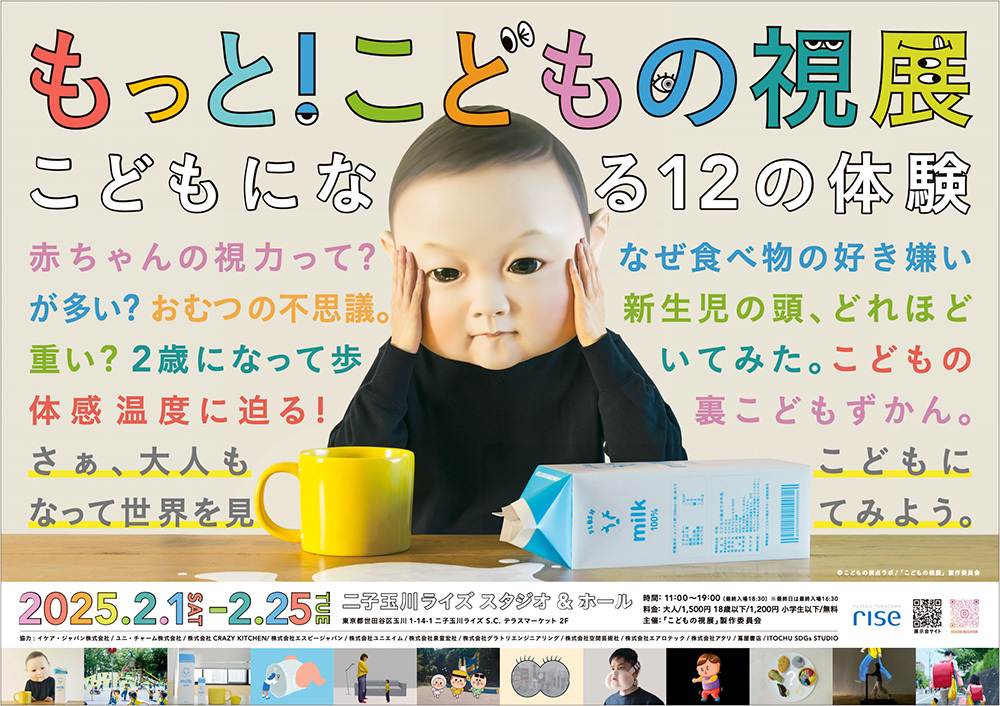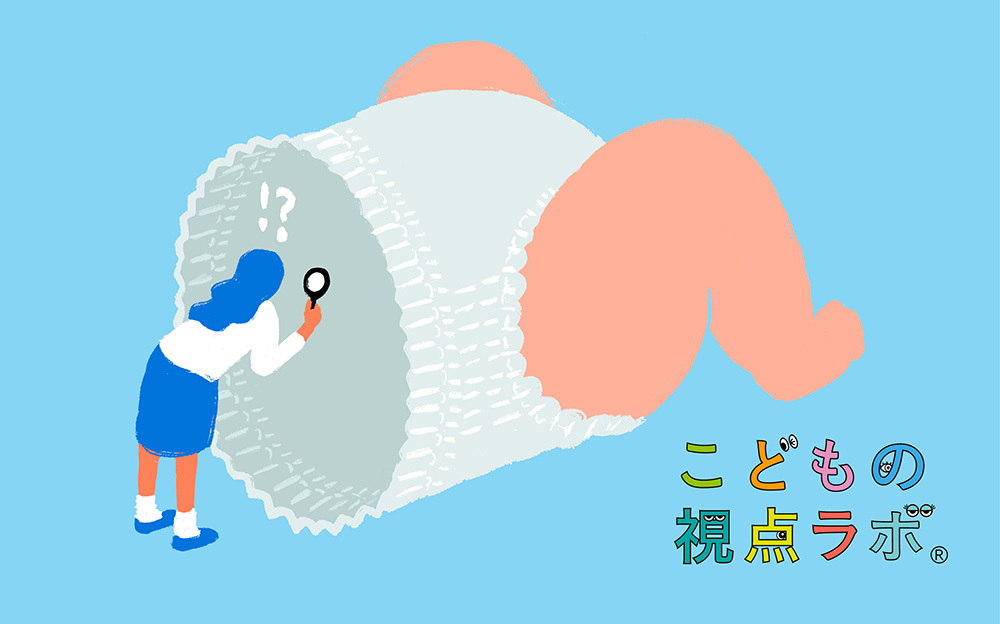
Is it okay to keep using diapers like this?
My 3-year-old daughter wears pants at daycare to match her classmates, but at home, she's almost exclusively in diapers. As a parent, the thought of accidents and hunting for a children's toilet makes potty training feel like a chore. Yet, seeing how her peers are potty trained, I can't help but feel a little anxious lately that she's falling behind.
This research delves deep into the world of diapers, led by Kenji Ozaki, who shares these anxieties, and Kumiko Ota, a mom of three whose youngest is 1 and firmly in the thick of diaper life.
Is running around in a bulging diaper hard training!?
They run around in diapers bulging to the brim, but isn't it heavy and hard to move in? Don't they feel uncomfortable or think it smells bad and want a change? Imagining a child's perspective brings up countless questions about diapers. Even after reading various articles on the topic, answers are hard to come by.
So, for diaper questions, we turned to the diaper pros! With the cooperation of Unicharm, we interviewed the team actually researching and developing diapers. Responding to our interview were Yuko Matsuda from Marketing, Akiko Tange from Research, and Hikari Kawata from Product Development.
Ozaki: Watching my 3-year-old daughter's diapers, they never leak at all—they seem incredibly high-performance. How much pee and poop can modern diapers actually hold?
Unicharm (UC): We design based on two key capacity concepts: water-holding capacity (the amount the diaper can securely retain without liquid leaking out when squeezed or pressed) and absorption capacity (the amount the diaper can hold without liquid leaking out when turned upside down). For a 3-year-old, you'd likely use size L or nighttime diapers. In terms of water-holding capacity, size L diapers hold about 330g, while nighttime diapers hold about 450g. For absorbency, size L diapers hold about 450g, and nighttime diapers hold about 600g. Of course, this varies slightly depending on the specific diaper type.
Ozaki: I see. That's quite a lot they can hold. Sometimes I get complacent and leave it on too long, but that's like an adult wearing a weight of about 2.18kg(※) on their bottom...
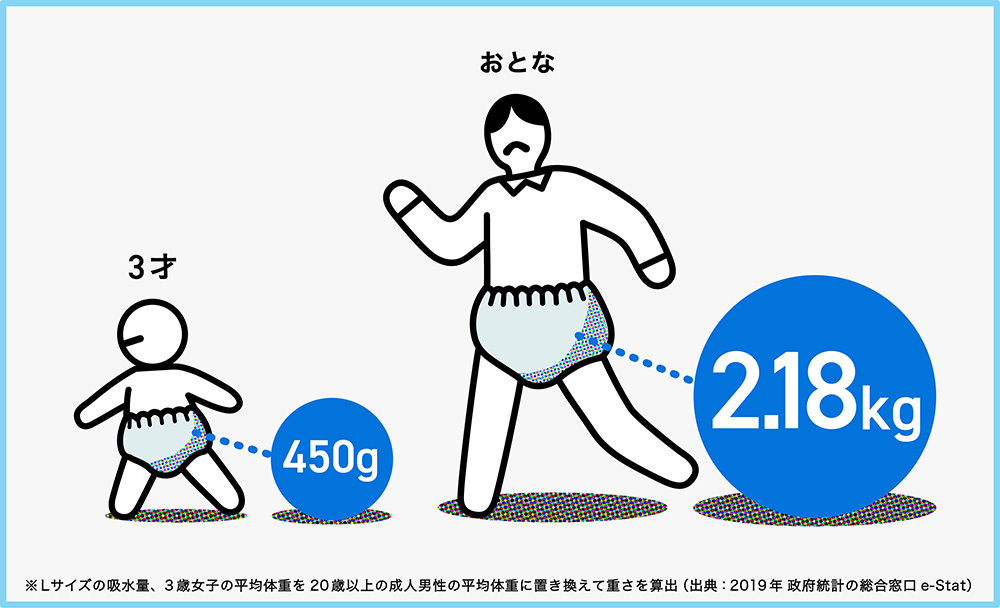
UC: That's right. Since they're running around the park like that, it might be like intense physical training for the child.
Ota: I'm starting to feel bad for the kids... Even so, they seem to handle it pretty well. Do they just think, "Oh, this is how it is"?
UC: The amount of urine per trip is only about 40 grams, not that much, and it gradually gets heavier. They probably adapt to it, so they might not even notice the weight.
Ozaki: Getting used to the weight gradually—it really is like training, isn't it?
Both "disgusting" and "smelly" come after social skills develop.
Ota: Even if you don't notice the weight gradually increasing, don't you feel uncomfortable when you've got a lot of pee stored up?
UC: Defining pleasure and discomfort is tricky, but while they understand the sensation of urine flowing on their skin, it's said that understanding that as "disgusting" requires social development.
Ota: So even though they feel the urine flowing, they don't perceive it as "disgusting"! That explains why they seem perfectly fine even with a diaper that's bulging.
UC: Incidentally, recognizing poop as "smelly" is also said to be a sign of social development.
Ozaki: I can sort of understand needing social development to feel "disgusting," but "smelly" seems more instinctive to me.
UC: Of course, the sensory function for perceiving smell is innate, as shown in experiments where newborn infants turn their faces toward either cotton pads soaked in water or cotton pads soaked in breast milk. It's also thought that we instinctively avoid smells that signal danger. However, poop isn't life-threatening. The recognition that poop smells "bad" is actually a social construct.
Ozaki: Other research in our lab often reveals that senses adults assume are innate or obvious are actually acquired as children develop. So feelings like "disgusting" or "smelly" are also tied to a child's growth.
UC: That's right. But this isn't unique; it's true for most things. There's rarely empirical evidence. So, theories are built around the idea that because they undergo this physical or neurological development, they must be accepting it, feeling it, understanding it. Babies might actually possess much deeper sensitivities than we realize.
Inside the diaper was like a tropical rainforest during the rainy season!
Ota: My one-year-old daughter often pees the moment her diaper comes off. If the feeling of "disgust" comes later, then that initial reaction wasn't from the comfort or freedom of being diaper-free, was it?
UC: That's so relatable. Before they graduate from diapers, they're eliminating urine reflexively, like it's overflowing from the bladder. It's not coming out because of a pleasant feeling of relief. The humidity inside a diaper can be over 90% at its peak. It's thought to be a biological function: the cold sensation stimulus from the cool air that rushes in when the diaper comes off causes the bladder to reflexively tighten, making the urine overflow.
Ozaki: So that phenomenon isn't about feeling good—it's caused by stimulation! Over 90% humidity? That's like the rainy season in a tropical rainforest. No wonder the cold stimulus must be intense.
UC: That's right (laughs). If you hold your pee too long, the "diaper climate" might actually be comparable to a tropical rainforest.
Ozaki: So there's actually a term for "diaper climate"?
UC: Home economics has the term "clothing microclimate," and similarly, diapers have a "diaper microclimate." They even evaluate this "diaper microclimate" using mannequins. Initially, urine is completely contained, but with repeated use, the diaper can't absorb it all. This leads to more moisture remaining inside the diaper, increasing the humidity within it.
Ota: We've also had cases of diaper rash. Considering the rash, it's clear we should change the diaper before the "diaper microclimate" becomes as humid as a tropical rainforest.
UC:High humidity makes the skin damp and swollen. This makes it more vulnerable to physical irritation and also allows biological irritants like bacteria and mold to penetrate more easily, which is definitely not good for preventing skin irritation. Of course, there are individual differences, but whether irritation occurs depends more on how swollen the skin has become by that point than on the timing of the diaper change.
Ota: So there's no specific timing for when to change diapers?
UC: We don't have specific timing recommendations for diaper changes, but we do advise changing them frequently for cleanliness.
Ozaki: So it's important to change them properly to prevent bacteria from multiplying, right? I'll be careful.
Children can usually control their bladder around age 3.
Ozaki: Even so, as a parent, there are times when there's no place to change diapers, and I find myself wishing the child could hold it. At what age can children actually start holding their pee?
UC:Actually, to hold urine, the urethral sphincter muscle needs to be properly developed. On top of that, they need to develop the understanding that "it's okay to go here because this is the toilet," and the neural development to consciously contract the sphincter muscle. Around the time toilet training stabilizes—meaning, on average these days, around 36 to 39 months—they can start controlling their urge to urinate like adults.
Ozaki: So, they can't hold it until then?
UC: It's said that until around age 2, when they feel the urge to urinate, they can't fully control the process and elimination happens.
Ota: By the way, when you're out with a child and ask, "Are you okay with the bathroom?" and they say "I'm fine!", only to start saying "I need to go to the bathroom!" about five minutes later, leading to situations where you scold them, "But I just asked you!" Is it really that hard for them to hold it in?
UC: Even after they start learning to hold it, they might manage a few minutes at first, but it takes a bit more time before they can reliably hold it for longer periods.
Ota: So for kids, the urge to pee comes suddenly, and they can't hold it for very long yet.
UC: Even if you scold them with "I told you just now!", they probably never imagined they'd feel the urge so soon . Kids haven't yet built up enough experience to gauge when the urge might hit or how long they can hold it. Plus, they have limited experience with situations like train schedules when out and about, so it's understandable.
Ota: Adults understand the balance—like thinking, "I don't need to go now, but I will soon, so I'll go now." That's because we have a lot of experience. I realize now that when I scolded them, I was thinking from a very adult perspective. I regret that.
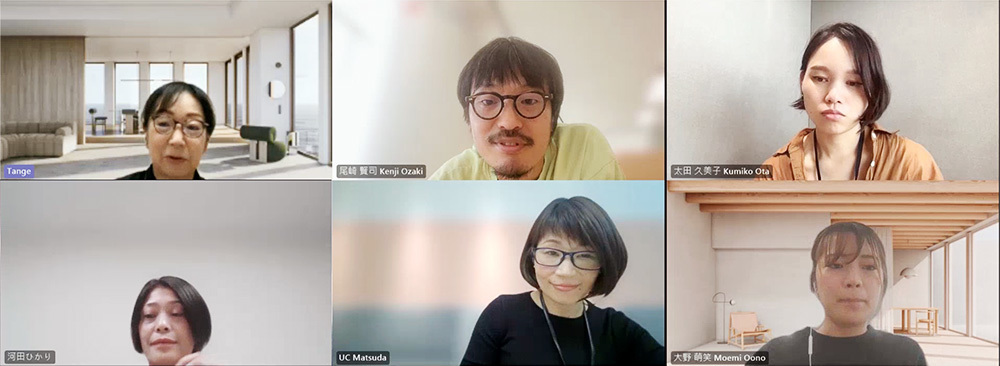
Scene from the remote interview with Unicharm
Three Milestones for Smooth Diaper Graduation
Ozaki: Finally, could you share some insights on transitioning out of diapers? Earlier, you mentioned toilet training typically stabilizes around 36 to 39 months. My three-year-old daughter still prefers diapers at home. I imagine many parents, like us, feel a bit anxious when training isn't progressing. How can we smoothly transition her out of diapers?
UC: Actually, a joint study by Professor Yuichi Ikeda from Showa University School of Medicine's Department of Pediatrics, BabyJob, and Unicharm found that waiting until a child develops sufficient autonomy before starting training leads to smoother diaper independence. Starting too early when they're not ready takes longer and leads to leaks even with training pants. Identifying the right timing is crucial. So, how do you determine that right time? It hinges on three key developmental milestones.
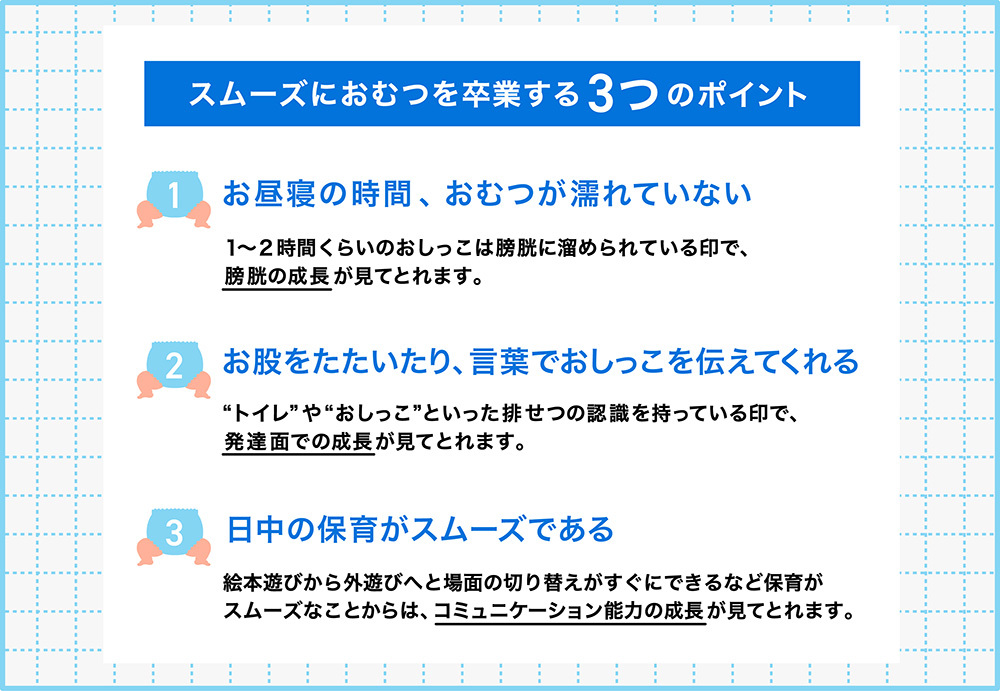
UC: These were identified through experiments with childcare workers. When all three points align, training often finishes sooner. The third point might be especially difficult for parents to assess, but childcare professionals can recognize it. For example, if a child doesn't respond after being told twice, "Okay, that's it, time for outdoor play now," during picture book time, it indicates childcare isn't running smoothly. Experiments showed that such children tend to progress more slowly in training. So, their communication skills are still underdeveloped, meaning it's too early to start training.
Ota: I wish I'd known this sooner (laughs). The third point is a bit tricky, but I think you can sense some level of communication development during everyday interactions at home, like when talking or giving instructions.
Ozaki: Parents whose kids have already outgrown diapers often say things like, "They'll be out of them soon." But parents right in the thick of potty training aren't in that mindset. Knowing these three points should help calm those feelings considerably.
Diapers are still evolving
Ozaki: I even wondered if my daughter wasn't potty training because diapers were just too comfortable (laughs). Actually, hearing stories about childcare from my own mother or from friends abroad really makes me appreciate how amazing Japanese diapers are.
UC: I think diapers have evolved significantly compared to the past. Now, Japanese diapers are high-spec products that don't leak at all, setting the global standard. But honestly, I still think there's room for improvement. We've even tried making larger sizes ourselves, but they're incredibly uncomfortable. They're rough and constricting. To further evolve such diapers, our research lab brainstorms various ideas and conducts experiments daily.
Ozaki: So there's still room for improvement. But hearing your stories, I've resolved to fulfill my duties as a parent—checking the diaper's hygiene meticulously and carefully monitoring my child's growth—without becoming complacent about these advancements. Mr. Tange, Mr. Kawada, Mr. Matsuda, thank you for your valuable insights today.
UC: Regarding diaper development, baby diapers still have a lot of research to be done, and many aspects are viewed from an adult perspective. Hearing your questions really made me realize again how important the child's perspective is. Thank you all for your time.
Digging deeper into diapers revealed how deeply they relate to child development: feelings of "discomfort" or "smell," the urge to hold and control urine, and the optimal timing to start potty training. Here's a summary:
● A diaper stuffed with urine is like having a 2.18kg weight strapped to your butt for intense training. Change it frequently.
● Before social awareness develops, children lack sensations like "disgusting" or "smelly" and won't complain. The inside of a diaper can reach over 90% humidity when damp, causing skin to soften and making it easier for bacteria and mold to enter. Pay close attention to hygiene and change frequently.
● Children can start controlling their urge to urinate around age 3. Even then, their ability to hold it is much shorter than an adult's, and their experience with the urge is still limited. When they say "I'm okay!" to "Are you okay using the toilet?", they genuinely mean it. Adults should skillfully guide them to the toilet!
● Starting potty training after the child's "bladder," "developmental growth," and "communication skills" have matured leads to a smoother transition out of diapers. Since physical and mental development varies, there's no need to rush.
Now, we're currently creating an experiential exhibit where you can literally step inside a giant diaper and experience it with your eyes, ears, and nose—based on what we learned through this research.
You can experience this, along with all our previously published research, at the "More! Children's Vision Exhibition" held at Futakotamagawa Rise Hall from Saturday, February 1, 2025, to Tuesday, February 25, 2025. Please come visit!
【Motto! Children's Vision Exhibition Overview】
Dates: Saturday, February 1, 2025 - Tuesday, February 25, 2025
Hours: 11:00 AM - 7:00 PM (Last entry at 6:30 PM)
※Last entry at 4:30 PM on the final day
Venue: Futakotamagawa Rise Studio & Hall
(2F, Futakotamagawa Rise S.C. Terrace Market, 1-14-1 Tamagawa, Setagaya-ku, Tokyo)
Admission: Adults: ¥1,500 / Under 18: ¥1,200 / Elementary school students and younger: Free
Organized by: "Children's Vision Exhibition" Production Committee
Cooperation: IKEA Japan Co., Ltd., Unicharm Corporation, CRAZY KITCHEN Co., Ltd., ESP Japan Co., Ltd., UNI-AIM Co., Ltd., Izumi Nobuhiro Co., Ltd., Grator Engineering Co., Ltd., Space Art Co., Ltd., Aerotech Co., Ltd., Atari Co., Ltd., Tsutaya Books, ITOCHU SDGs STUDIO















